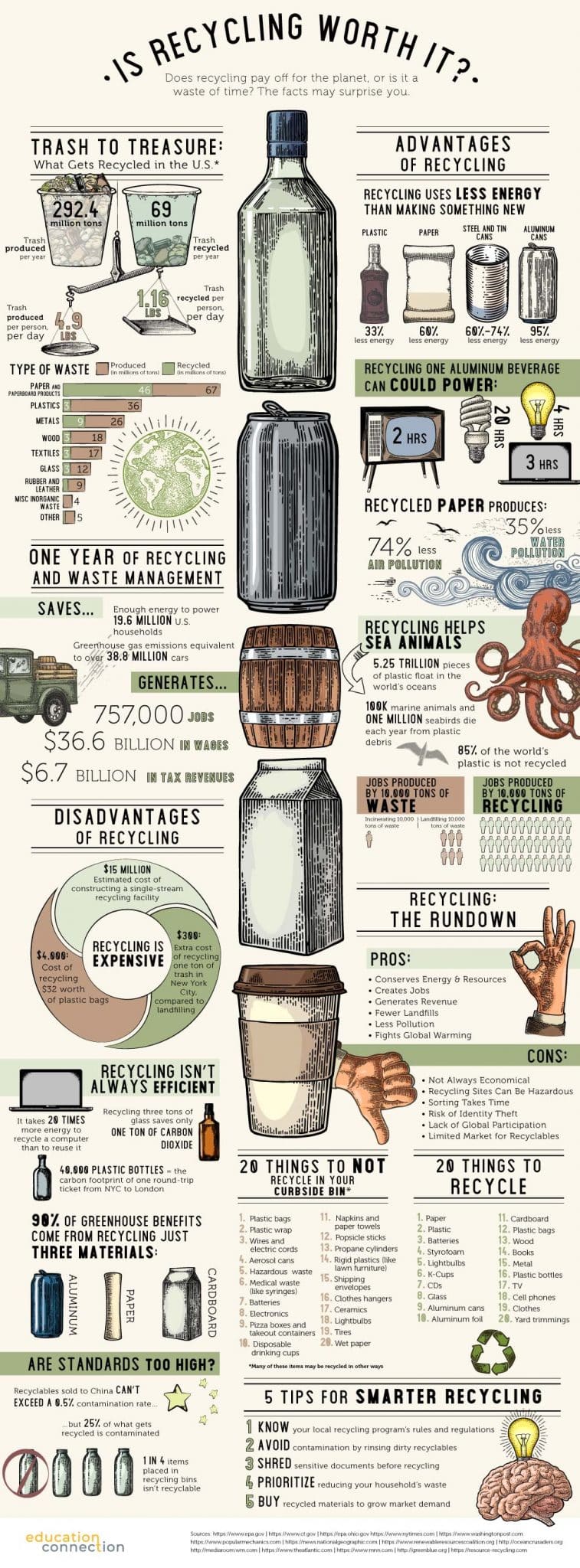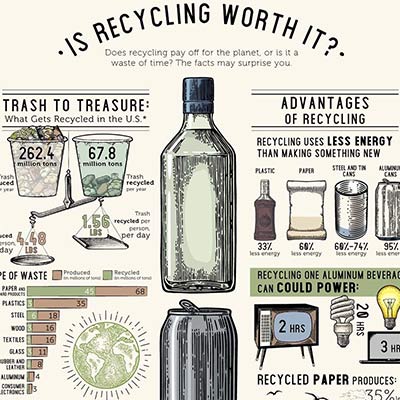Do These Facts Suggest Recycling is a Waste of Time?
Plus, Jobs and Degrees That Have a Positive Impact on the Planet
Table of Contents
Does recycling pay off for the planet, or is it a waste of time? The facts may surprise you.

Want to use this infographic on your site? Just use the code below!
Is Recycling Worth It?
Did you know that that in the U.S., the total generation of municipal solid waste (MSW) in 2018 reached an astounding 292.4 million tons? This translates to approximately 4.9 pounds of waste generated per person per day.
YIKES!
On the flip side, only around 69 million tons were recycled, and a mere 25 million tons were composted. In total, approximately 94 million tons of municipal solid waste (MSW) were recycled and composted, resulting in a recycling and composting rate of 32.1 percent. This significant disparity between the amount of garbage we dispose of compared to what we recycle raises the question of why the balance is so skewed.
Advantages of Recycling
Recycling presents numerous compelling reasons to choose it over discarding items. One key benefit is that recycling requires less energy compared to manufacturing new products. For instance, recycling plastic utilizes two-thirds less energy, while paper uses 60% less energy. When it comes to steel and tin cans, recycling saves between 60 and 74 percent of the energy used to produce them from raw materials. Moreover, recycling a single aluminum beverage can conserves enough energy to power a 14-watt CFL bulb (equivalent to a 60-watt incandescent) for 20 hours, a computer for 3 hours, or a TV for 2 hours.
Great right? Well There is more.
By producing recycled paper, we effectively cut down air pollution by an impressive 74%, along with a notable reduction of 35% in water pollution compared to the production of virgin paper. This conservation of energy holds great potential as it can be harnessed for a multitude of other purposes.
Moreover, the process of generating recycled paper not only exemplifies its environmental benefits but also highlights its significant advantages. It leads to a substantial 74% decrease in air pollution and a commendable 35% reduction in water pollution when contrasted with the production of paper from virgin sources. To further underscore the importance of recycling, consider the remarkable impact of recycling one ton of steel: it slashes air pollution by an astounding 86%, reduces water pollution by an impressive 76%, while concurrently saving an impressive 74% of energy and an essential 40% of water that would have otherwise been consumed.
Shifting our focus, let’s consider the example of recycling just one aluminum can. This seemingly small act holds immense potential, as it has the capability to power:
- A TV for two hours
- A computer for three hours
- A 100 watt light bulb for 4 hours
- A 14 watt CFL light bulb for 20 hours
Ultimately, if an office building with 7,000 employees recycles all its paper, plastic, and corrugated waste annually, it could make a significant impact on reducing greenhouse gas emissions. Specifically, this green initiative could result in a reduction of 1,200 metric tons of carbon equivalent, which is comparable to taking 900 cars off the road for a whole year.
Recycling plays a crucial role not only in conserving energy but also in significantly reducing CO2 emissions. Some opponents of recycling tend to focus on products with low returns, such as plastic and green glass. However, materials like aluminum cans offer a highly positive impact, with recycling saving approximately 95% of the energy required for their initial production due to the energy-intensive nature of manufacturing aluminum.
Statistics from The Balance Small Business reveal that about 69% of the crude steel used in the U.S. in 2019 was sourced from recycled materials, while the EPA estimates that 68% of all paper and cardboard is effectively recycled. These figures indicate that recycling actively reduces the consumption of raw materials and contributes to energy conservation.
The environmental benefits of recycling are evident. By minimizing energy consumption and curbing CO2 emissions, recycling proves to be a more sustainable option. The Waste & Resources Action Programme (WRAP) commissioned analyses from the Technical University of Denmark and the Danish Topic Centre on Waste, which found that recycling was environmentally superior in 83% of the examined scenarios. This highlights the crucial role recycling plays in promoting a greener and more eco-friendly world. (Economist.com – The Truth about recycling)
The Cons of Recycling
While recycling is often seen as an environmentally friendly practice, it can sometimes be less cost-effective compared to other waste management methods. In the U.S., the cost of recycling materials like glass can range from $70 to $90 per ton, yet the recycled product, known as cullet, may sell for only about $10 per ton . This economic imbalance can make recycling less appealing, especially for municipalities with tight budgets.
Plastic recycling faces its own set of challenges. As of 2025, the U.S. plastic recycling rate remains around 5%, the lowest among developed countries. Factors contributing to this low rate include the complexity of sorting different types of plastics and the limited availability of recycling facilities. Moreover, the process of recycling plastics can be resource-intensive, sometimes requiring significant amounts of water and energy, which may offset some of the environmental benefits.
Glass recycling also presents difficulties. Although glass is 100% recyclable, the process can be inefficient. Recycled glass often ends up as cullet, which, due to its low market value, may not justify the costs associated with collection and processing. In some cases, recycled glass is transported to recycling facilities only to be redirected to landfills, leading to additional transportation emissions and costs.
These challenges highlight the importance of evaluating the economic and environmental impacts of recycling programs. While recycling remains a key component of waste management, it’s crucial to consider its limitations and explore complementary strategies such as reducing consumption, reusing materials, and investing in more efficient recycling technologies.
5 Tips for Smarter Recycling
- Familiarize yourself with the rules and regulations of your local recycling program. Knowing what is accepted in your recycling bin will ensure you don’t inadvertently contaminate the recycling process.
- Ensure recyclables are clean by rinsing dirty items before placing them in the recycling bin. Clean recyclables are more likely to be accepted and processed effectively.
- Shred sensitive documents before recycling to protect your privacy. Identity theft is a serious concern, so taking this extra step adds security to the recycling process.
- Focus on reducing your household waste in the first place to minimize the need for recycling. Reducing waste at the source is an essential step in promoting sustainable practices.
- Support the recycling industry by purchasing products made from recycled materials, which helps create a demand for recycling. By buying products made from recycled materials, you contribute to creating a demand for recycling, thus encouraging more sustainable production practices.
Jobs/Degrees That Have a Positive Impact on the Planet
Degrees in:
- Sustainability
- Environmental Science
- Environmental Engineering
- Forestry or Natural Resources
- Agriculture and the Environment
Careers:
- Environmental Scientist or Specialist
Median annual salary, 2023: $78,980 - Environmental Engineer
Median annual salary, 2023: $100,090 - Conservation Scientist
Median annual salary, 2023: $68,750 - Agricultural or Food Scientist
Median annual salary, 2023: $76,400
Financial Aid Info
- Your Guide to Federal Student Loans
- Grants and Scholarships
- Military Benefits
- Private Student Loans
- Repaying Student Loans
- Student Loan Consolidation
- Education Tax Credits | AOTC & LLC
- 15 Military Scholarships to Apply For in 2023
- Grad School Scholarships
- 12 Graduate Scholarships for DACA Students in 2025
- Graduate Scholarships for International Students
- Grants for Women
- Guide Schools & Scholarships for Students with Disabilities
- Guide Tribal Colleges and Scholarships for Native Americans
- 8 Adult Scholarships for Adults Returning to School
- How to Earn Credit for College with Life Experience
- The Psychology of Lying
- 36 Companies That Pay For College
- FAFSA: Parent and Student Assets
- How Do You Get Student Loans Without a Job?

